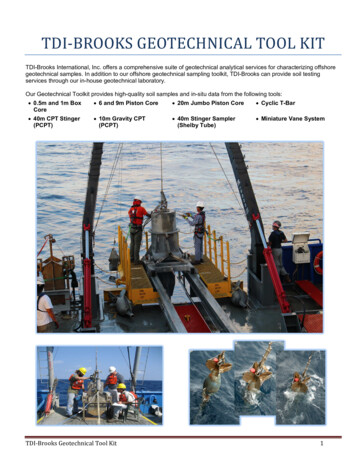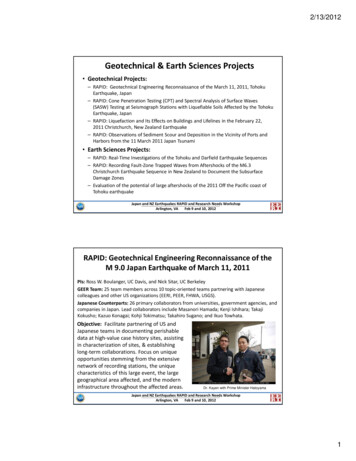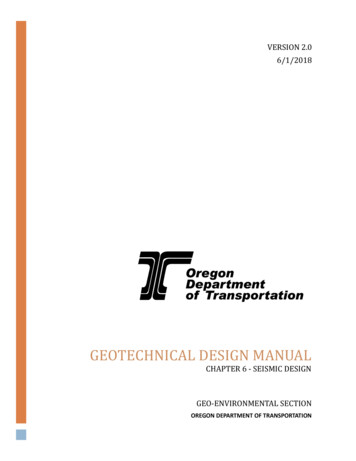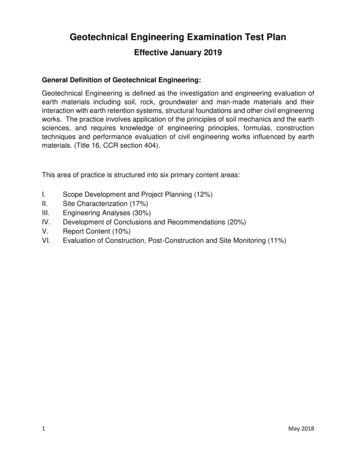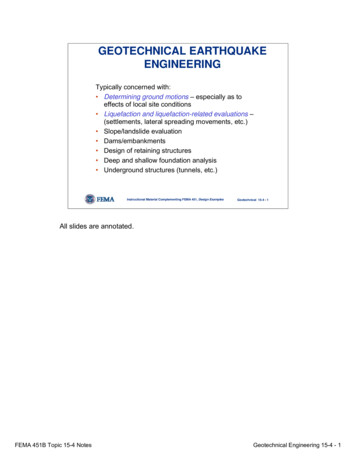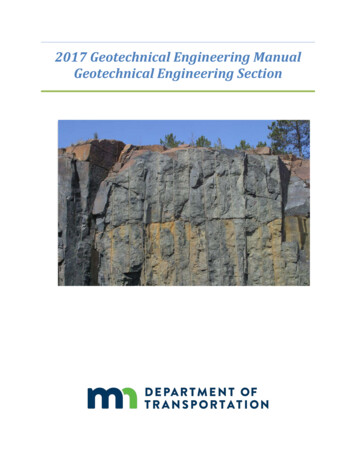
Transcription
9Geotechnical and Geophysical Studies forWind Farms in Earthquake Prone AreasFerhat Ozcep1, Mehmet Guzel2 and Savas Karabulut11Istanbul2MESUniversityYeraltı Araştırma, AdanaTurkey1. IntroductionAs Redlinger et al (2002) point out, since antiquity; people have used technology totransform the power of the wind into useful mechanical energy. Wind energy is acceptedone of the world’s oldest forms of mechanic energy. The re-emergence of the wind as asignificant source of the world’s energy must rank as one of the significant developments ofthe late 20th century (Manwell et al, 2009).Across the Earth’s surface, wind is in horizontal motion. Wind power is produced bydifferences in air pressure between two regions. Wind is a product of solar energy like mostother forms of energy in use today. Wind is a clean, abundant, and renewable energyresource that can be tapped to produce electricity. Wind site assessments include: (1) highelectricity rates, (2) rebates or tax credits from utilities or governments, (3) a good windresource, and (4) a long-term perspective (Chiras, 2010).Procurement costs for critical components and subsystems are given in Table 1. The criticalcomponents of Wind Turbines include blades, rotor shaft, nacelle, gear box, generator, andpitch control unit. The tower, site foundation, and miscellaneous electrical and mechanicalaccessories are characterized as subsystem elements. As you can see in Table 1, mediumpercent cost of site and foundation is 17.3. For this reason, soil investigation should carefullybe carried out for the wind energy systems.2. Soil investigation procedures for wind energy systemsSite investigation is part of the design process (Day, 2006). A foundation is defined as thatpart of the structure that supports the weight of the structure and transmits the load tounderlying soil or rock. The purpose of the site investigation is to obtain the following(Tomlinson, 1995): Knowledge of the general topography of the site as it affects foundation design andconstruction, e.g., surface configuration, adjacent property, the presence ofwatercourses, ponds, hedges, trees, rock outcrops, etc., and the available access forconstruction vehicles and materials. The location of buried utilities such as electric power and telephone cables, watermains, and sewers.www.intechopen.com
192 Wind Farm – Technical Regulations, Potential Estimation and Siting AssessmentThe general geology of the area, with particular reference to the main geologicformations underlying the site and the possibility of subsidence from mineral extractionor other causes.The previous history and use of the site, including information on any defects orfailures of existing or former buildings attributable to foundation conditions.Any special features such as the possibility of earthquakes or climate factors such asflooding, seasonal swelling and shrinkage, permafrost, and soil erosion.The availability and quality of local construction materials such as concrete aggregates,building and road stone, and water for construction purposes.For maritime or river structures, information on tidal ranges and river levels, velocity oftidal and river currents, and other hydrographic and meteorological data.A detailed record of the soil and rock strata and groundwater conditions within thezones affected by foundation bearing pressures and construction operations, or of anydeeper strata affecting the site conditions in any way.Results of laboratory tests on soil and rock samples appropriate to the particularfoundation design or construction problems.Results of chemical analyses on soil or groundwater to determine possible deleteriouseffects of foundation structures.ComponentPercent of Total System CostMedium PercentCostRotor blades3 to 11.27.1Gear box and generator13.4 to 35.424.4Hub, nacelle and shaft5.3 to 3. 518.4Control system elements4.2 to 10.27.2Tower5.3 to 31.118.2Site and foundation8.4 to 26.217.3Miscellaneous engineering3.2 to 11.47.3Table 1. Estimated Procurement Costs of Critical Components of Wind Turbines (Jha, 2010)An approach for organizing a site investigation assessment is given In Table 2. Geotechnicalsite characterization requires a full 3-D representation of stratigraphy (including variability),estimates of geotechnical parameters and hydrogeological conditions and properties(Campanella, 2008).The natural materials that constitute the earth’s crust are rather arbitrarily divided byengineers into two categories, soil and rock. Soil is a natural aggregate of mineral grains thatcan be separated by such gentle mechanical means as agitation in water (Terzaghi and Peck,1967). in a dynamic sense, seismic waves generated at the source of an earthquakepropagate through different soil horizons until they reach the surface at a specific site. Thetravel paths of these seismic waves in the uppermost soil layers strongly affect theircharacteristics, producing different effects on earthquake motion at the ground surface.Local amplification caused by surficial soft soils is a significant factor in destructiveearthquake motion. Frequently, site conditions determine the types of damage frommoderate to large earthquakes (Bard, 1998; Pitikalis, 2004; Safak, 2001).www.intechopen.com
193Geotechnical and Geophysical Studies for Wind Farms in Earthquake Prone AreasSite InvestigationPlanningAdministrationGround InvestigationPreliminaryFeasibilityMain studyGeotechnicalEvaluationRecords and reportsPriliminaryAssesmentPlannedStrategy andprogrammecontingencyproposalsDesk thodMaterial andGroundwatercharacteristicsField cialisedStudiesGeophysicsDevelopment ofInvestigationStrategyDynamic andstatic probesProgramme ofSite ActivityPresurmentersas per codeFactual /IntraprativeReportDilatometersHydrographicTable 2. Planning and Design of Site Investigations (Head, 1986)The design of a foundation, an earth dam, or a retaining wall cannot be made intelligentlyunless the designer has at least a reasonably accurate conception of the physical propertiesof the soils involved. The field and laboratory investigations required to obtain this essentialinformation constitute soil exploration (Ozcep, 2010). There are several soil problems at localand regional scale related to the civil engineering structures (Ozcep, F. and Zarif, H., 2009;Ozcep, et al 2009;2010a, b, c Korkmaz and Ozcep, 2010).2.1 Subsurface explorationIn order to obtain the detailed record of the soil/rock media and groundwater conditions atthe site, subsurface exploration is usually required. Types of subsurface exploration are theborings, test pits, and trenches. Many different types of samplers are used to retrieve soiland rock specimens from the borings. Common examples show three types of samplers, the‘‘California Sampler,’’ Shelby tube sampler, and Standard Penetration Test (SPT) sampler(Day, 2006).www.intechopen.com
194Wind Farm – Technical Regulations, Potential Estimation and Siting Assessment2.2 Field testingThere are many different types of tests that can be performed at the time of drilling and/orproject site. The three types of field tests are most commonly used geotechnical practice:Standard Penetration Test (SPT), Cone Penetration Test (CPT) and Geophysical Tests.2.2.1 Standard Penetration Test (SPT)The Standard Penetration Test (SPT) consists of driving a thick-walled sampler into a sanddeposit. The measured SPT N value can be influenced by many testing factors and soilconditions. For example, gravel-size particles increase the driving resistance (henceincreased N value) by becoming stuck in the SPT sampler tip or barrel. Another factor thatcould influence the measured SPT N value is groundwater (Day, 2006).2.2.2 Cone Penetration Test (CPT)The idea for the Cone Penetration Test (CPT) is similar to that for the Standard PenetrationTest, except that instead of a thickwalled sampler being driven into the soil, a steel cone ispushed into the soil. There are many different types of cone penetration devices, such as themechanical cone, mechanical-friction cone, electric cone, seismic and piezocone (Day, 2006).2.2.3 Geophysical testsBroadly speaking, geophysical surveys are used in one of two roles. Firstly, to aid a rapidand economical choice between a number of alternative sites for a proposed project, prior todetailed design investigation and, secondly, as part of the detailed site assessment at thechosen location. Geophysical methods also have a major role to play in resource assessmentand the determination of engineering parameters. The recently issued British Code ofPractice for Site Investigations (BS 5930:1999) sets out four primary applications forengineering geophysical methods:1. Geological investigations: geophysical methods have a major role to play in mappingstratigraphy, determining the thickness of superficial deposits and the depth toengineering rockhead, establishing weathering profiles, and the study of particularerosional and structural features (e.g. location of buried channels, faults, dykes, etc.).2. Resources assessment: location of aquifers and determination of water quality;exploration of sand and gravel deposits, and rock for aggregate; identification of claydeposits.3. Determination of engineering parameters: such as dynamic elastic moduli needed tosolve many soil-structure interaction problems; soil corrosivity for pipeline protectionstudies; rock rippability and rock quality.4. Detection of voids and buried artefacts: e.g. mineshafts, natural cavities, oldfoundations, pipelines, wrecks at sea etc.2.2.3.1 Seismic testsSeismic tests are conventionally classified into borehole (invasive) and surface (noninvasive)methods. They are based on the propagation of body waves [compressional (P) and/orshear (S)] and surface waves [Rayleigh (R)], which are associated to very small strain levels(i.e. less than 0.001 %) (Woods, 1978). Seismic surveys provide two types of information onthe rock or soil mass (McCann et al, 1997):www.intechopen.com
Geotechnical and Geophysical Studies for Wind Farms in Earthquake Prone Areas 195Seismic refraction and reflection surveys may be carried out to investigate thecontinuity of geological strata over the site and the location of major discontinuities,such as fault zones.From measurements of the compressional and shear wave velocities it is possible todetermine the dynamic elastic moduli of the soil/rock mass and estimate its degree offracturing2.2.3.2 Electrical resistivity measurementsElectrical depth soundings are effective in horizontal stratified media, since the spatialdistribution of the electrical current in the ground and, hence, the depth of investigationdepends on the configuration of the array and the spacing of the electrodes. When using aStandard Wenner or Schlumberger array the depth of investigation increases with thecurrent electrode spacing and this gives rise to an electrical resistivity depth section whichcan be related to the geological structure beneath the survey line (McCann et al , 1997).2.3 Laboratory testingIn addition to document review, subsurface exploration and filed tests, laboratory testing isan important part of the site investigation. The laboratory testing usually begins once thesubsurface exploration and tests is complete. The first step in the laboratory testing is to login all of the materials (soil, rock, or groundwater) recovered from the subsurfaceexploration. Then the engineer prepares a laboratory testing program, which basicallyconsists of assigning specific laboratory tests for the soil specimens (Day, 2006).2.3.1 Index testsIndex tests are the most basic types of laboratory tests performed on soil samples.Index testsinclude the water content (also known as moisture content), specific gravity tests, unitweight determinations, and particle size distributions and Atterberg limits, which are usedto classify the soil (Day, 2006).2.3.2 Soil classification testsThe purpose of soil classification is to provide the geotechnical engineer with a way topredict the behavior of the soil for engineering projects (Day, 2006).2.3.4 Shear strength testsThe shear strength of a soil is a basic geotechnical parameter and is required for the analysisof foundations, earthwork, and slope stability problems (Day, 2006).3. On geophysical and geotechnical parameters based on site-specific soilinvestigationsA geotechnical study (i.e site-specific soil investigation) must be carried out for all “WindFarm” projects. All geotechnical designs must be based on a sufficient number of borings,geophysical and geotechnical tests. At each foundation of Wind Energy System (WES),integrated use of one borehole, geophysical and geotechnical tests is strongly recommended.If some sites vary in soil features, different number of suitable boreholes is made on theedges of the proposed foundation, based on discussions and meetings with thewww.intechopen.com
196Wind Farm – Technical Regulations, Potential Estimation and Siting Assessmentgeotechnical/geophysical/geological engineers according to the local soil characteristics.Related to the static and dynamic loads, the parameters and problems such as foundationbearing capacity, settlement, stiffness, possible degradation, soil liquefaction andamplification must be investigated in detail.There are an interaction between tower stiffness, foundation stiffness and soil stiffness, andthese are formed total stiffness of Wind Energy System (WES).Engineer requires to calculate static and dynamic coefficients of compressibility by using thesoil dynamic properties such as:· Gd [MN/m²] - dynamic shear modulus· ρ [kg/m³] - soil density [t/m³]; the moist density of natural soil, in case of watersaturation including the water filling the pore volume, is introduced as density· [ν ] - Poisson’s ratio.The dynamic properties of the soil material are obtained by using geophysical testing. Thesegeophysical (spectral analysis of surface waves, seismic CPT, down-hole, seismic cross-holeseismic refraction and reflection, suspension logging, steady-state vibration) tests are basedon the low-strain tests. It does not represent the non-linear or non-elastic stress strainbehavior of soil materials. These studies must be performed by a qualified geophysicalengineer or geophysicists.The sampling intervals of SPT (standard penetration test) should not be in excess of 1 to1.5m. CPT (cone penetration testing tests) is recommended, because they continuously givethe soil properties with depth. All soil layers that influence foundation of project must beinvestigated.3.1 Soil settlement criteriaThe settlement analysis is taken in to consideration as immediate elastic settlements (primer)and time-dependent consolidation (secondary) settlements. For the tower, a foundationinclination has 3mm/m permissible value after settlement. In the case of the dynamicanalysis of the machine, it should be considered additional rotations of the tower baseduring power production.The completely vertical long-term settlement due only to the gravity weights is less than20mm in any case. This situation should be verified by Geotechnical Engineer.The safety factor for failure of the soil material (soil shear failure) should be min.3.3.2 Stiffness requirementsWind Energy Structures (WES) are subject to strong dynamic stresses. Dynamic systemproperties, i.e. in particular the natural frequencies of the overall system consisting of thefoundation, tower, machine and rotor, are therefore of particular importance for loaddetermination.The foundation structures in interaction with the foundation soil, is modeled byapproximation using equivalent springs (torsion and linear springs). Figure 1 provides acomparison between wind turbine generator system and the simplified analysis model. Eachmodel parameter is dependent on soil properties.Over its design lifetime, the foundation of wind energy structure must provide theminimum levels of stiffness required in the foundation loads. The rotation of the foundation(and resulting maximum permissible vertical settlement of the foundation soil) under theoperational forces is limited to be less than the values of rotational stiffness.www.intechopen.com
Geotechnical and Geophysical Studies for Wind Farms in Earthquake Prone Areas1973.3 Ground water and dewatering requirementsThe two properties of a rock or soil which are most important in controlling the behaviourof subsurface water are (a) how much water the rock or soil can hold in empty spaces withinit, and (b) how easily and rapidly the water can flow through and out of it (McLean andGribble, 1985).For all required foundation excavation depths, ground water table level shall be considered.Excavation dewatering due to high ground water levels, presence of water bearing strata orimpermeable materials (rock, clays, etc.) must be considered as required by specific siteconditions.Fig. 1. Wind energy system and the analysis model.3.4 Design of wind energy systems to withstand earthquakesEarthquakes impose additional loads on to wind energy systems. The earthquake loading isof short duration, cyclic and involves motion in the horizontal and vertical directions.Wind energy system (The tower and foundation) need to withstand earthquake forces.Earthquakes can affect these systems by causing any of the following: Soil settlement and cracking Liquefaction or loss of shear strength due to increase in pore pressures induced by theearthquake in systems and its foundations; Differential movements on faults passing through the foundationwww.intechopen.com
198Wind Farm – Technical Regulations, Potential Estimation and Siting Assessment Soil amplification Soil bearing capacity reductionThe potential for such problems depend on:The seismicity of the project areaSoil / rock materials and topographic conditions at the site;The type and detailed construction of the wind energy system;The groundwater level in the wind energy system at the time of the earthquake.As shown in Figure 2, the focal distance from an earthquake to a point on the earth’s surfaceis the three dimensional slant distance from the focus to the point, while the epicentraldistance is the horizontal distance from the epicentre to the point. Possible earthquakemagnitude and these factors (epicentral distance, focal dept and focal distance) are related tothe ground motion level at the project site.Fig. 2. The focal distance from an earthquake to a point on the earth’s surface.3.4.1 Evaluation of seismic hazardFor a given project site, a seismic hazard evaluation is to identify the seismic sources onwhich future earthquakes are likely to occur, to estimate the magnitudes and frequency ofoccurrence of earthquakes on each seismic source, and to identify the distance andorientation of each seismic source in relation to the site. When the deterministic approach isused to characterize the ground motions for project site, then a scenario earthquake isusually used to represent the seismic hazard, and its frequency of occurrence does notdirectly influence the level of the hazard. In the other hand, when the probabilistic approachis used, then the ground motions from a large number of possible earthquakes areconsidered and their frequencies of occurrence are key parameters in the analysis(Somerville and Moriwaki, 2003).3.4.1.1 Probabilistic approachGiven the uncertainty in the timing, location, and magnitude of future earthquakes, and theuncertainty in the level of the ground motion that a specified earthquake will generate at awww.intechopen.com
Geotechnical and Geophysical Studies for Wind Farms in Earthquake Prone Areas199particular site, it is often appropriate to use a probabilistic approach to characterizing theground motion that a given site will experience in the future (Somerville and Moriwaki,2003).The probabilistic estimation of ground motion requires the following seismicity informationabout the surrounding area: The rate of occurrence and magnitude of earthquakes; The relative proportion of small to large events (b value); The maximum earthquake size expected The spatial distribution of earthquake epicenters including delineation of faults3.4.1.2 Seismic hazard from known active faults: deterministic approachThis method is used where faults in the vicinity of the wind farm can be identified. Theprocedure will usually include: Identification of major faults within the vicinity of the wind farm. Assessment of whether the faults are active or potentially active, by consideration ofwhether modern (including small) earthquakes have been recorded along the fault. Assessment of the maximum earthquake magnitude on each identified fault. This willusually be determined by considering the length and/or area of the fault and the typeof fault. The likely focal depth and, hence, focal distance are also estimated.3.4.1.3 Selection of design seismic loadingThere are two ways of selecting the design seismic loading: deterministic and probabilistic.Whichever approach is taken, the bedrock ground motions need to be adjusted whereappropriate for amplification (or de-amplification) effects. The probabilistic approach toseismic hazard characterization is very compatible with current trends in earthquakeengineering and the development of building codes. Examples of conceptual frameworksare given in Figure 3.Fig. 3. Seismic performance objectives for buildings (SEAOC, 1996), showing increasinglyundesirable performance characteristics from left to right on the horizontal axis andincreasing level of ground motion from top to bottom on the vertical axis. Performanceobjectives for three categories of structures are shown by the diagonal lines (Hall et all,1995).www.intechopen.com
200Wind Farm – Technical Regulations, Potential Estimation and Siting Assessment4. Bahce (Osmaniye, Turkey) case for wind energy systems(from Ozcep et al, 2010)4.1 IntroductionGeological observations, geophysical measurements, soil explorations, in-situ tests andlaboratory tests have been performed over the study area. This survey has been realized inorder to be able to decide basic systems in an element, which is one of the turbine locationsof Wind Power Plant (135 MW) that is planned to be constructed in Bahçe county ofOsmaniye province and in order to be used as a basis for the superstructure loads to betransferred to the soil in detail. Presentation of the location map of the site with severalcities and main seismogenetic fault described in Figure 4.1a.Fig. 4.1a. Presentation of the location map of the site with several cities and mainseismogenetic fault4.1.1 Geological frameworkFrom the structural point of view; Amanos Mountain is located over the intersections of thetectonic zones or within the impact area of these zones which are well known world wide.At Nur Mountain, characteristic folding and faulting properties are being observed.Overturned, overthrust and canted folding in different scales are observed. Spring waterwww.intechopen.com
201Geotechnical and Geophysical Studies for Wind Farms in Earthquake Prone Areasand percolating water are becoming dense in the western part and are being observed overdiscontinuity zones depending on the structural geology. These springs and percolationshave resulted important amount of decomposition over the main rock. The engineeringproperties of the geological units differ from one region to another depending on thestructure and hydro-geology and types of rocks. Study area is near the Eastern AnatoliaFault zone which is strike slip fault zone. Eastern Anatolia Fault has not been formed of onlyone single fault but has been formed of as a complex fault system or zone.4.1.2 Seismic hazard analysis of regionSeismic hazard analyses aim at assessing the probability that the ground motion parameterat a site due to the earthquakes from potential seismic sources will exceed a certain value ina given time period (Erdik et al, 1999, Erdik and Durukal, 2004). Deterministic andProbabilistic approaches are used in developing ground motions in professional practice.The deterministic approach is based on selected scenario earthquakes and specified groundmotion probability level, which is usually median ground motion or median-plus-onestandard deviation. The probabilistic approach encompasses all possible earthquakescenarios, all ground motion probabilities and computes the probability of the groundmotion to be experienced at the site exceeding a certain value in a given time period.Empirical attenuation relationships are generally employed in the quantification of seismichazard in either deterministic or probabilistic approaches (Seismic Microzonation forMunicipalities: Manual, 2004).For deterministic seismic hazard analysis, two fault model are selected namely A (faultrapture is 50 km) and B faults (fault rapture is 245 km) within east Anatolian fault Zone(Table 4.1.1a and 4.1.1b).ResearcherM (magnitude)Magnitude TypeAmbraseys and Zatopek (1969)M (0,881 LOG(L)) 5,62MsDouglas and Ryall (1975)M (LOG(L) 4,673)/0,9MsEzen (1981)M (LOG(L) 2,19)/0,577MsToksöz et al (1979)M (LOG(L) 3,62)/0,78MsWells and Coppersmith (1994)M 5,16 (1,12 LOG(L))MwTable 4.1.1a. Equations for Rapture Length and Magnitude Estimationswww.intechopen.com
202Wind Farm – Technical Regulations, Potential Estimation and Siting AssessmentResearchersM (magnitude)Estimations For AModelM (magnitude)Estimations For B ModelAmbraseys and Zatopek (1969)7,17,5Douglas and Ryall (1975)7,17,6Ezen (1981)6,77,5Toksöz et al (1978)6,87,4Wells and Coppersmith (1994)7,17,6Table 4.1.1b. Selected two fault model (A : fault rapture length is 50 km) and B : fault rapturelength is 245 km) within East Anatolian Fault Zone.Earthquake ranges for analysis were taken from 4.5 to 7.5 about 100 km radius (Table 1c)Gutenberg-Richter recurrence relationships was determined asLog(N) a – b M(1)Earthquake occurrence probability were given by usingRm 1- e - (N(M) . D)Where Rm Risk value (%); D, duration; N(M) for M magnitude (1) equation value.MagnitudeRanges4.5 M 5.05.0 M 5.55.5 M 6.0Number ofEarthquakes3496Table 4.1.1c. Earthquake Magnitude ranges in study area about 100 km radius. Data areobtained by BU KOERI, compiled by Kalafat et al, 2007)Attenuation relationship was defined by several attenuation models (see Table 4.1.2a). Froma set of attenuation relationships, the average acceleration values of the cities was calculatedwith exceeding probability of 10 % in 50 years by using several attenuation models asshown in Table 4.1.2b and c.www.intechopen.com
Geotechnical and Geophysical Studies for Wind Farms in Earthquake Prone Areasa Acceleration Value (cm/sn2)PHA Pick Horizontal AccelerationM Earthquake MagnitudeD Epicentral Distance (km)R Radial Distance from Focal depth (km).a 1300 e0.67M (R 25)-1.6.log a 3.09 0.347 M – 2 log (R 25)log (a/g) -1.02 0.249 M – log R –0.00255 R 0.26where; R (D2 7.32)0.5203ResearchersDonovan (1973)Oliviera (1974)Joyner and Boore (1981)ln (aH) (-3,512 0,904M-1,328 ln [(Rseis2) (0,149 e0,67M)2 ]0,5 (0,44-(0,171 ln(Rseis)) (0,405-(0,222 ln(Rseis)))Campbel (1997)where, M is moment magnitude; Rseis is shortest distanceto seismogenetic faultTable 4.1.2a. Used Acceleration Attenuation Relationships in this StudyFigure 4.1.1b. shows active fault zones, earthquakes in historical and instrumental periodsnear study area. Seismic hazard analysis for the region are carried out on the earthquakesbigger than 4.5 for 106 years of period.Fig. 4.1.1b. Active fault zones, earthquakes (M larger than 5.5) in Historical and Instrumentaltime intervals around the Study Area (a quadrangle) (map is redrawn by Erdik et al, 1999)Poisson probabilistic approach is applied to earthquake data. Table 2b. shows earthquakeprobability (%) for selected year by Poison distribution in the study area, and Table 2cshows ground motion level at the site exceeding (%10) in a given time period (50 years).www.intechopen.com
204Wind Farm – Technical Regulations, Potential Estimation and Siting AssessmentProbability (%) For D (Year)Magnitude105075100AverageReturn 6,223,329,72817,51,26,08,811,6802Table 4.1.2b. Earthquake Occurrence Probability (%) for D (Year) by Poison distribution inthe Study AreaD (year)Probability ofExceedence (%)M (magnitude)50107,2 , EpicentralDistance (km)H, Focal depth(km)2515Donavan(1973)Oliviera (1974)Joyner andBoore (1981)Campbell (1997)0,260,190,590,45forforEstimated a(g)Table 4.1.2c. Ground motion probabilities show the probability of the ground motion to beexperienced at the site exceeding (10%) in a given time period (50 years).4.3 Site investigations4.3.1 Test pitsInformation has been obtained from observation purpose superficial excavations and in thelaboratory evaluations, drilling samples have been used.4.3.2 Drilling wellsAs a result of the observations and analysis performed over the survey area and nearenvironment, it has been planned and realized 2 drilling (SK-1 on the middle of the base,SK-2 at the edge of the base) wells with 30 meter over the area at which the constructionbase will be settled (Table 4.3a).www.intechopen.com
Geotechnical and Geophysical Studies for Wind Farms in Earthquake Prone AreasBorholeSK-1SK-2205Depth (m)LITHOLOGY0,00 – 7,50gray colored, faulted and fractured, melted cellular fromplace to place limestone with rarely calcite filled faults,calcite grained, with brown colored decompositionsurfaces7,50 – 30,00gray colored, melted cellular limestone with browncolored decomposition surfaces, calcite grained fromplace to place, fractured, medium sometimes thicklayered0,00 – 7,50gray colored, faulted and fractured, melted cellular fromplace to place limestone with rarely calcite filled faults,calcite grained, with brown colored decompositionsurfaces7,50 – 30,00gray colored, m
2.2 Field testing There are many different types of tests that can be performed at the time of drilling and/or project site. The three types of field tests are most commonly used geotechnical practice: Standard Penetration Test (SPT), Cone Penetration Test (CPT) and Geophysical Tests. 2.2.1 Standard Penetration Test (SPT)
